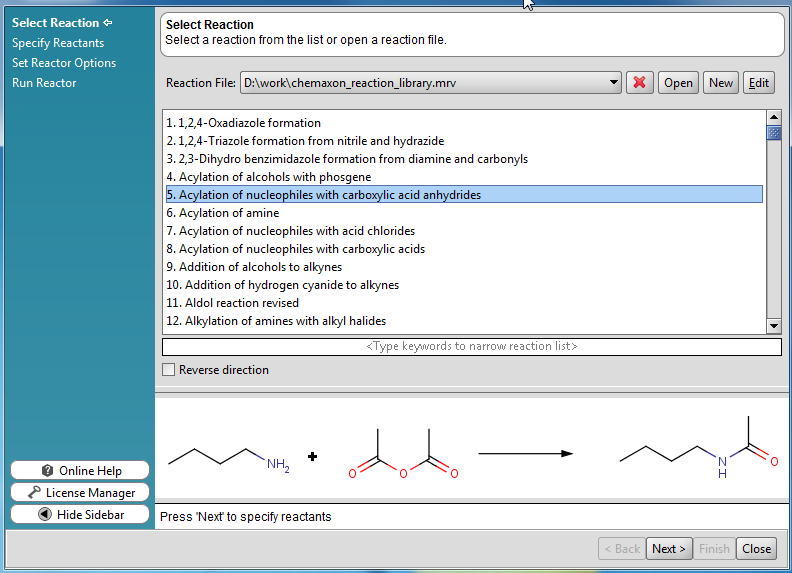Reaction Library
Introduction to the ChemAxon reaction library
Reactor users can enjoy a library of synthetic organic reactions predesigned by chemistry experts. Available data on the most often used organic chemical reactions was collected from the literature, then the reactions were written down with Reactor conventions to create ready-to-use forms of the transformations. The created reactions have been thoroughly reviewed in an iterative manner to ensure correctness and reliability.

The available reactions proceed via different types of reaction mechanisms:
-
addition
-
elimination
-
substitution
-
rearrangement
-
redox
-
condensation
-
hydrolysis
-
polymerization
Several different types of compounds may be involved in the reactions as well:
-
alcohols
-
alkanes
-
alkenes
-
alkyl halides
-
alkynes
-
amines
-
aromatic hydrocarbons
-
carboxylic acids
-
ethers
-
heterocycles
-
nitrocompounds
-
oxocompounds
-
phenols
Naming conventions:
Each reaction has an informative name such as Alkylation of amines with alkyl halides or Condensation reaction of primary amines and oxocompounds.
Well-known name reactions (named after its inventor(s)) are referred as common, for example Diels-Alder cycloaddition or Clemmensen reduction.
Using this nomenclature, chemists can easily recognize and understand the content of the reaction library. In addition, a comprehensive description of the chemical reactions is also provided along with examples and literature references.
ChemAxon does not consider the reaction library as a completed product. New reactions are added continuously and the existing ones are refined according to the tests and the feedback received via our forum.
Using the ChemAxon library in Reactor
Find the Reaction library:
-
in the JChem package as a zip file (<jchem_home>\doc\user\config_downloadables\chemaxon_reaction_library.zip),
-
or download it separately.
To browse the content of the library, start Reactor and click Open on the starting page. Find the reaction library file on your computer and select it. The built-in reactions will then be listed in Reactor:

If you select a reaction from this list, an example appears in the lower panel that shows a possible transformation. No more preparatory steps are required after the selection, just simply proceed to the Specify Reactants panel by clicking Next.
Though these reactions were designed to produce feasible products, the predictions can be further improved if needed via the Reaction Editor. To learn more about this, see Advanced Settings.